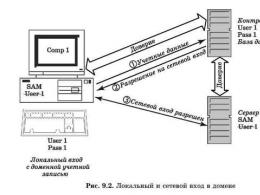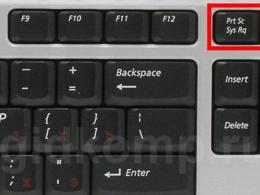Do-it-yourself mouse repair. Mouse button not working
A mouse is a device that helps the user to work on a computer. When it breaks, many users do not know as far as possible, from the keyboard, they will switch to the desired system icons. This situation causes the session to end and search for service centers for the repair of electronic equipment, or for the acquisition of a new device. If you have such qualities as perseverance, attentiveness, the ability to work with a tester and a soldering iron, then without any problems, based on the information provided, you can quickly determine the cause of the failure of the device and even repair it. Consider renovation wireless mouse with your own hands.
Causes of breakdown.
Since the mouse is a reliable technique, therefore, in many cases, the breakdown will be insignificant. It can happen due to:
1. Poor contact between the battery and the control board.
2. Failure of one of the electronic components.
3. Port failures Computer USB.
Identification of the cause of the malfunction and methods for its elimination.
To start the study of a broken device, you need to disconnect it from the power supply, remove the module from the USB computer wireless communication and remove the battery. To get to the control board in most models, just unscrew the fasteners located under the battery and use a flat screwdriver to disconnect upper part housings from latches.

Visually or with a multimeter in the position of checking semiconductor devices, examine the plus and minus marks, connecting wires and soldering points for the presence of oxides, mechanical damage. Due to strong vibrations, mechanical stresses, microcracks can occur at the junctions of the elements with the tracks of the board.

To identify them, you need to very carefully examine and shake the fasteners of the wires, the electronic components of the board. When identifying suspicious or defective areas, they should be properly soldered.
If the measures described above did not ensure the restoration of the device's operability, check its resistance on the power terminals. It should be in the range of 400 - 600 ohms. If the ohmmeter shows zero, then in the electronic circuit there is short circuit, if one - break. In these situations, it is necessary to check the electronic components. Detected charred, swollen appliances must be replaced.
To check the health of the photodiode, connect the probe from the “V +” port to its positive input, and the probe from the “COM” port to the negative input. At the same time, the multimeter is switched to the diode test mode. Turn on the phone's camera and point its lens at the photodiode. A healthy element will glow in the displays.

If after all the above measures the mouse did not work, we check the serviceability wireless module with USB plug. With the probe from the “COM” port, touch track 2, and with the other probe, track 1. The readings should be 600 - 800 ohms.

For USB test port of the computer, it is enough to connect a working device to it, such as a keyboard or a memory drive. If after connection software responds, then the port is operational.
In other cases, when the breakdown could not be eliminated, a replacement chip is required.
Reading time: 3 min.
A computer mouse is a key mechanism for comfortable work with a computer. It can be used to control the PC menu functions. Since the mouse is used actively, it also breaks often and unexpectedly. Its device is not distinguished by a complex design. The mouse can be completely disassembled and repaired with your own hands, armed with a minimum set of tools and knowledge. To find out how to disassemble a mouse without consequences without consequences, you should study the features of its fasteners.
Fastening Features
The mouse consists of two parts of the body, a wheel and internal parts. The top case is divided into two main buttons. Between themselves, the upper and lower parts are fastened with bolts. Usually, manufacturers hide them under the heels or stickers. Most mice have four mounting screws located under the legs on the bottom of the case. These legs are used for easy sliding on the rug. They peel off and stick back on.

Often there are devices with one bolt on one side of the case. The second side is fixed with latches. If the screws are not visible at all, then there are latches around the entire perimeter. To disassemble the mouse, you need to lightly press on them.
Inside is a printed circuit board, most often not fixed with screws. It is mounted with holes on plastic rods protruding from the body. In some models, the board is screwed on with one or more bolts.
Device repair
A computer mouse can fail for various reasons. The most common:
- clogging;
- oxidation of metal contacts;
- breakage of the wheel axle;
- wire damage.

Almost all problems can be fixed at home. To do this, you need to follow some steps:
- Prepare the necessary tools.
- Disconnect the mouse from the computer.
- Disassemble the case by pressing on the latches or unscrewing the screws.
- Open the halves of the case with a screwdriver with a rubber or plastic bit, which will not leave scratches on the plastic of the device.
- You need to disconnect the parts of the mouse carefully, without sudden movements, so as not to break the internal wires.
- There is a chip inside. It must be disconnected and removed from the groove, as well as remove other buttons, if we are talking about a gaming mouse.
- After repair, assembly must be carried out in the reverse order.
Repair may consist of such manipulations:
- Broken wire should be soldered.
- A broken wheel axle can be made from a regular paper clip.
- Clogged areas should be cleaned with a special cloth or a clean soft cloth.
After carrying out all the necessary activities, you can proceed with the assembly. First, the wheel is put in place, the board is screwed on and additional buttons are returned to their place. Then you need to carefully connect the body halves and screw in the bolts, or press the parts against each other at the location of the latches until a characteristic click. The mouse is assembled - you can check its work.
Instrument preparation

To disassemble and repair the mouse, you will need a minimum set of tools:
- screwdriwer set;
- scissors;
- soldering iron.
Medical gloves should be used to avoid leaving greasy fingerprints on the board or internal contacts during the repair process. To eliminate blockages, you need a special napkin. In extreme cases, a piece of soft, clean cloth will do. Do not use water with detergents or solvents for cleaning. You need to take regular alcohol. They can moisten a cotton pad and wipe the board, wheel, case from the inside. Optical sensor clean with a toothpick with cotton wool, also dipped in alcohol.
Wireless Mouse Repair
Wireless devices often fail due to dead batteries. If the mouse stops responding to movement or does not respond well to manipulation, then most likely the batteries should be replaced. Majority wireless models have a light indicator of operation, so the serviceability of the batteries is checked by a glowing red indicator.

Discharged batteries are easy to remove. On the "sole" of the mouse, you need to open the compartment cover and remove the batteries. It also does not hurt to check the contacts in the device and on the terminals of the batteries. Over time, they oxidize. The resulting raids are removed with a rag soaked in alcohol. It is not recommended to use sandpaper - you can remove the protective galvanic film.
Computer mouse - small but very important device for PC users. It experiences a large mechanical load during active operation. Over time, this leads to breakdowns, most of which can be fixed at home. A few screwdrivers, a soft rag, ammonia and gloves, as well as a little patience and a serious approach to repairs, will save money and time.
Often the cause of such problems is the usual clogging. There are frequent cases when something is spilled on the mouse, and not always ordinary water, but, for example, hot sweet coffee. In such situations, there are two options: get a new device or try to fix the old one.
If you know how to disassemble the mouse, you can avoid downtime at the computer and fix the problem yourself.
The main reasons for the breakdown of a computer "rodent"
Find out what caused the problem first. You may not need to disassemble the mouse. So, the main types of breakdowns are as follows:
- technical - frayed wire, damage to USB or PS / 2 connectors;
- mechanical - incorrect operation of the scroll wheel, lack of response to button presses;
- wrong setting for specific application or games.
The latter situation does not require repair of the manipulator. enough to produce necessary settings. Before disassembling the mouse, make sure that the cord (in the case of a wired device) and the connector are intact. If the cause of the breakdown lies in them, it is useless to do so. When the manipulator does not respond to user actions due to the idle state of the scroll wheel, clogging and other reasons, there is nothing left but to start repairing.
Required Tools
How to disassemble a mouse? This does not require a wide range of tools. It is enough to arm yourself with a Phillips screwdriver and prepare a container for the reliable safety of the screws. IN otherwise, when it comes to assembly, they may simply not be in place. Carried away by work, the master sometimes simply sweeps them away with his hand, without noticing it himself. And finding these small details is very difficult.
Instructions for disassembling a wired mouse
Perform the following sequence of actions:
- Disconnect the mouse from the computer and turn it upside down.
- Below are the mounting screws. They can not be immediately noticed under the stickers. In this case, clean the surface of the instrument and remove the screws.
- Open the case by holding the mouse with both hands on different halves. You need to be extremely careful, otherwise you can break off the latch, which is located on the cover near the wire.
- A scroller (scroll wheel) is removed from the base of the device. To do this, slightly pull it up. The wheel should come out with the latch or fastener.
- Remove the chip or mouse board. If it is secured with latches, use your fingers to pry them off, being careful. If screws are used, they are unscrewed and placed in the prepared container. The board is easily separated from the case by pulling it up.

Wired mouse disassembly is complete. After troubleshooting, collection is performed in reverse order. Be careful, some parts are fragile and can be damaged even with a little force.
Wireless Mouse Disassembly: Logitech
Modern manipulators are not connected to the computer with a cord. Logitech is the leading manufacturer of wireless mice. Despite all the shortcomings, which, however, have already been eliminated, these devices are considered among the best.
So, how to disassemble a Logitech mouse:
- Remove the screws holding the two halves of the case together. To do this, you will need to undermine the elastic pillows: one in front and two in the back. There is no other way to get to the screws.
- Carefully detach the two halves of the housing.
- In the upper part there is a small board connected to the main board with a cable. To disconnect, remove it from the connector, and then pry it with a screwdriver. plastic latch. It is an element of fixing the loop.

The question of how to disassemble a Logitech mouse has been answered. It is assembled in the same way, only the steps should be performed in reverse order.
Wireless mouse disassembly: A4tech Bloody
The use of a high-quality laser sensor in the manipulator is an indisputable advantage. This is exactly what A4tech mice with the Bloody brand are ready to boast of. They belong to the game class.
How to disassemble A4tech Bloody mouse? More on that in the instructions below:
- Unscrew the two screws that are on the case and remove the top. To do this, pry it slightly, being careful not to damage anything.
- Turning the mouse frame over, you can see a metal plate. Unscrew it.
- Remove the mouse wheel. If there is dirt or hair, clean it. If you disassemble the Bloody mouse, you will see that the wheel consists of two parts.
- To remove the board, carefully unscrew the screw.

Now it became clear how to disassemble the A4tech mouse. To assemble it, follow the same steps, only in reverse order.
As practice shows, disassembling a computer mouse is not difficult. It is enough to follow the basic rules:
- perform all actions carefully so as not to inadvertently damage the fragile elements of the device;
- make sure that none of the details are lost;
- if there are legs, be sure to install them in place, otherwise it will be difficult to work with the manipulator;
- if latches are present, note that there should be a click when they are secured.
Before disassembling a wireless mouse or device with a cord, evaluate your own strengths and skills. Maybe, the best option will take the device for repair, where it will be repaired by experienced specialists.

Given the ubiquitous use of computers that is observed today, the instruction "How to disassemble a mouse" will come in handy in various situations.
Computer mice manufactured in this moment have good reliability. They can work without repair for several years. However, over time they refuse to work. You have to buy a new mouse or repair the old one yourself. Since in the workshop they take a lot of money for this.
Often, the breakdown of the mouse is due to chafing of the wire at the exit from the case or poor contact that occurs in the mouse buttons. Often, this is the left key, since it is most often used by itself. To repair the mouse, you have to disassemble it.
How to disassemble a computer mouse
The first step is to unscrew the mounting screws, they are located on the bottom side. There may be several of them, but almost always it is one screw. This model mouse fastens the case with one screw.
If the screw cannot be found, it is labeled. Press on the label, if it bends, the screw is located under it. To disassemble this mouse, I had to partially peel off the sticker.

Model TECH X-701 is fastened with two screws. One of them is under the label. When an attempt was made to peel off the label, it began to tear. I had to find the screw and unscrew it without removing the sticker. The location is marked with a blue circle in the photo.

If there are no screws under the sticker, then they are hidden behind the thrust bearings. They should be peeled off with a knife. After the mouse is repaired, the thrust pads should be returned to their place. If this is not done, the mouse will not slide well on the mat.

After all the actions, the mouse cover, on which the buttons are located, is removed.

Most often, the printed circuit board is not fixed in the mouse body. It is simply put on plastic rods. If, when you try to remove the board, it does not lend itself, then you should look for screws. This model of the mouse with the help of a screw fixes two elements at once: the case and the board.

The board is removed by prying it from below, while the wheel axle should be removed from the latches.

Carefully inspect the mouse before disassembling, remember the location of the parts. Pay attention to the wheel ratchet spring, if any. It is similar to a clothespin spring, only the size is smaller. If you do not like the rotation of the wheel, bend the ends of this spring. Then the wheel will rotate softer by reducing the pressure.
Make sure that during disassembly, your fingers do not touch the optical prism and optics. If this happens, do not use any detergents. There are special wipes for removing greasy stains. If they are not available, wipe the optics with a dry cloth.
How to repair a frayed mouse wire
If while working at the computer you began to observe unauthorized movement of the cursor or freezing, the reason for this may be a broken wire. This is easy to check. Press the wire to the mouse body and make a movement. If the cursor moves along a given axis, it's all about the explorer.

If damage is noticed at the point where the wire exits the mouse, the reason for the breakdown of the mouse is in it. Here is one example of a breakdown. The photo clearly shows that the outer sheath of the wire is damaged. Some conductors simply frayed. This mouse is in need of repair.

If you have the skill of working with a soldering iron, repairing the mouse is not difficult. It is enough to remove the damaged section of the wire, prepare new solder ends and solder them. It remains only to connect the wire to printed circuit board.
How to repair a frayed mouse wire by soldering
There are two types of wire connecting the mouse to the connector: tinsel and regular stranded. Tinsel is more elastic and soft wire. It is resistant to bending that occurs when using a mouse. As a result, it lasts longer.
The wire is laid along the body of the mouse and connected to printed circuit board. There are two options for attaching this wire. With the help of a detachable connection and by pressing into the board block. The photo shows a block that was soldered from the printed circuit board. Conductors are pressed into it.

In order not to forget the location of the wires in the board, it is better to take a photo. Then the connector or block is soldered from the board. In this case, it is better not to disconnect the wires. Color scheme wires may vary. Since there is no single standard, manufacturers select wires at their discretion.
I repaired different mice and in all the wires had a different color. Most likely, this is due to the fact that the repair of the mouse field warranty period not provided. After the old wires have been soldered out of the board, the remaining solder must be removed. To do this, heat it up with a soldering iron and, using a thin match or toothpick, squeeze the solder out of the hole. Places for new conductors are prepared.

Before you start soldering, you need to prepare the wires. Cut off a bad piece of wire to a length of 15-20 mm. We remove the insulation, tin the ends with solder. So that the tinned edges have round shape, the wires should be laid on a wooden stand and tinned by rotating. If this is not done, the wires will not go through the holes in the PCB. Then we insert them into the board and solder them according to the color marking.

Tinsel conductors are not amenable to tinning with rosin flux. All because they are insulated with varnish. Acid in this case cannot be used, after a while it will destroy the conductor. It is best to take an aspirin tablet.


There are times when the printed circuit board has a small wire hole diameter. In this case, the conductors can be soldered to the pads. There will be no physical load on the wire, so this type of connection will be quite rigid.

Everything, you can return the printed circuit board to its place. We lay the wire and fasten the board with screws. Make sure that the wire does not touch moving parts, is not laid under the pushers of the buttons, is not pressed down by the body. Before closing the case with a lid, make sure that excess dirt and hairs are removed. You can use the mouse.
How to repair a frayed mouse wire with a twist
There is no way to find a more reliable way to solder to repair the mouse wire. However, not everyone has a soldering iron and not everyone can solder. If you are not the owner of a soldering iron, you can repair the wires by twisting. To do this, disassemble the mouse and cut off the section of the wire with a defect.

Using a sharp knife blade, cut the outer insulation at both ends of the wire. Approximately 5-6 cm.


The length of the conductor must be selected in such a way that when the wire is twisted, the joints are shifted by 5-8 mm relative to each other. The ends of the insulation must be stripped.

Conductors of the same color are twisted together.

The twists must be bent along the wires. Then tuck them into the previously cut insulation. Pay attention that the places of twists do not touch each other.

A second piece of insulation must be applied to the resulting connection.

This will increase mechanical protection and protection against contact with parts on the mouse board.

It remains to insert the wire connector into the connector on the printed circuit board. Then carefully lay the wire along the mouse body.

The mouse is covered top cover, the screws are tightened. You can use the mouse as intended. Wires connected in this way will last another lifetime. It happens that the mouse connector is located far away.
And the wire is not long enough to connect the mouse. Then, according to the same scheme, we increase the missing piece of wire. It can be taken from an old mouse. Wires may have different color coding because there is no single standard. Therefore, before we twist the wires, ring them. To increase the life of the mouse, make sure that the wires at the point of exit from the case are not bent.
If the mouse wheel is not working properly
Sometimes, when you rotate the wheel on the mouse, you notice that the page does not scroll at all or it happens in jerks. The reason for this may be the ingress of dust and hair between the photodetector of the optocoupler and the photo sensor of the wheel. So how does dirt get into a mouse? Through the gaps between the body and the wheel. Since there is a lubricant inside that improves glide, foreign objects stick to it.

After removing hair and dust, the wheel works like new.
How to replace a micro switch
If you find that nothing happens when you press the mouse buttons, you should start repairing. The reason for this may be the failure of their microswitch or the wear of the button, formed at the point of contact with the pusher.
To find out the reason, you need to disassemble the mouse and inspect it. If there is a slight indentation, about 1 mm, this may be the reason. Check pushers of buttons by pressing them. There should be a loud, clear click. If it doesn't, it's most likely the switch itself.
This is checked as follows: the disassembled mouse is connected to the computer, and by pressing the pushers, it is checked. If everything works, you need to melt the missing piece of plastic on the button, or pour a drop of epoxy. If the failure lies in the microswitch, it will have to be replaced.

It's easier to replace the whole switch than to mess around with soldering wires. Most mice use a standard microswitch. It works according to the following principle. 3 brass plates with a complex shape are pressed into the body made of plastic. Their ends have pins that are used for soldering into the board.
The plate on the left in the photo is the middle point of the switch. A plate having a hole in the shape of "P" is attached to it by the method of spreading. This plate is attached with the left side to the ledge of the left plate on the left side. The right side is curved in an arc, with it it catches on the protrusion located on the right on the left contact plate.
The flat thin plate is made in such a way that its right end is pushed up. Due to this, contact is created with a thick right plate, curved into the shape of the letter "G". While pressing the key, the pusher transmits force to a thin plate. Consequently, it goes down, moving away from the upper contact, and touches the lower one. The output of this contact is located in the middle of the button.
After you release the button, the thin plate returns to its original position, due to which the extreme contacts of the switch are connected. It turns out that when the button is pressed, the contacts are connected to each other. What does this happen with the middle and left contacts. When the button is released, the extreme contacts are connected.

Since the metal tends to accumulate fatigue, the spring is deformed and loses its property. That is why the button refuses to work. Maybe the microswitch can be repaired.
Disassemble, remove the spring and straighten it. But I have not had to repair the switch in this way. If you have an old ball mouse, take it apart and solder the microswitch.
It is better to solder the one that is located under the wheel. It is used the least often and is often serviceable. If the wheel is missing, take the switch right button. Just pay attention to how it is installed. The conclusions on the switch are arranged symmetrically to each other, it is easy to make a mistake.
If the old mouse is missing, swap the switches. In place of the left button, install the switch from the wheel and vice versa. If the situation is extremely hopeless, there is nothing left but to repair the microswitch.
Today I will tell you how to do minor repairs computer mouse . Many of you may ask: why? Indeed, today it is easier to buy a new mouse than to mess with a faulty one and try to repair something there. And in some way you will be right. But there are objects or things that you get used to or become attached to, and their replacement is not always equivalent.
A computer mouse is exactly the subject that you get used to imperceptibly, and the replacement of an old rodent with a new one is immediately felt.
First of all, this is the feeling of the mouse in the palm of your hand, as well as the convenience and strength of pressing the keys. And if you use an expensive mouse that you can’t just buy in a store. In a word, you can always throw out the mouse, but you need to try to give it another life.
To disassemble the mouse, you need to unscrew the screw, which is located in the rear lower part of the case. In my design, you can see that the screw is located under the silicone “leg”. And there are mouse designs where such screws are covered with paper stickers, and the sticker is usually pierced to get to the screw.

With the tip of a screwdriver or scissors, pry off the edge of the leg and peel it off, pulling it to the side. If you have a sticker, then we pierce.

Now we lift the upper part of the case and slightly pull it towards us so that it comes out of the grooves located in front of the base of the case.

In the following figure, the arrows mark some of the elements that are most subject to wear and tear, due to which the mouse starts to work poorly. Basically, these are microswitches and part of the USB cable at the entrance to the mouse body.

2. Faults.
The first common problem is when you move the mouse and the cursor stays in place, moves jerkily, or you have to move the mouse several times to get the cursor to move. Such a malfunction manifests itself when the USB cable frays at the entrance to the mouse body from repeated bending of the wire.
It is removed simply and easily..
Use scissors or a knife to cut off the damaged section of the USB cable, indicated by the dotted line.

To make it convenient to work, we remove the board from the case. To do this, you need to bend the two latches that secure the board from behind.
We remove the upper insulation of the cable, and clean the ends of the cores. Who has a soldering iron, the ends lived.



Now we connect all the veins of both ends of the USB cable to each other. We take two veins of the corresponding color, for example, red, and twist it, and if there is a soldering iron, then we solder it.
I had heat shrink, and to insulate the connection, I first put it on the ends of the wires. If there is no heat shrink, then you can use electrical tape, tape or any other flexible insulating material.

The next step is to isolate the twists or solderings of the cores, and then evenly lay them in one line to get a large twist. As shown on the bottom of the picture.

Now we cover the twists with insulating material. I used heat shrink again to make it look nice. Although this is not important, because all the same, this beauty will hide inside. But still.

If you solder a little, then there is another option where you do not need to twist or solder. Here, the damaged section of the USB cable is simply cut off, stripped, tinned and soldered under the connector from the side of the tracks. When soldering, the sequence of colors of the wires that go into the top of the connector is repeated.

Second common problem- this is when you have to click the left mouse button several times to perform some action. And it also happens like this: you click once, and the click occurs twice. The reason for all this is the microswitch, which presses the left key.
In this case, we already need a soldering iron. Here we do this: solder the microswitch of the left mouse button and the “wheel”, and swap them. Most people use the wheel only for scrolling through pages, and very few people use it as an additional button. Therefore, we put this microswitch in place of the worn-out left one.
The microswitch is easily soldered, although it has three leads.
With the tip of the soldering iron, we simultaneously touch the middle and any of the extreme conclusions, while trying to lift this edge with our finger. You don't need to press hard.

You should end up with something like this:

Now we intercept and solder the opposite side of the microswitch, where we also lift it with a finger, and heat the two terminals with a sting.

If it didn’t work the first time, that is, the microswitch remained on the board, then we repeat the soldering procedure again: first we solder one side, and then the second. When both microswitches are soldered, swap them and solder back.
Very often situations arise when part of the solder remains in the hole into which the leg of the radio component is inserted.

If necessary, this is eliminated as follows: a regular needle or a needle from a disposable syringe is taken and inserted into the hole from the side of the radio components, and from the side of the tracks this hole is heated with a soldering iron. As the solder warms up, the needle will enter the hole and force the solder out.
Now it only remains to assemble the repaired rodent in reverse order and enjoy its work. When you put on the upper part of the case, first insert it into the grooves and slightly push forward so that it goes all the way.
I think now it will be easy for you to do small computer mouse repairs.
Good luck!






